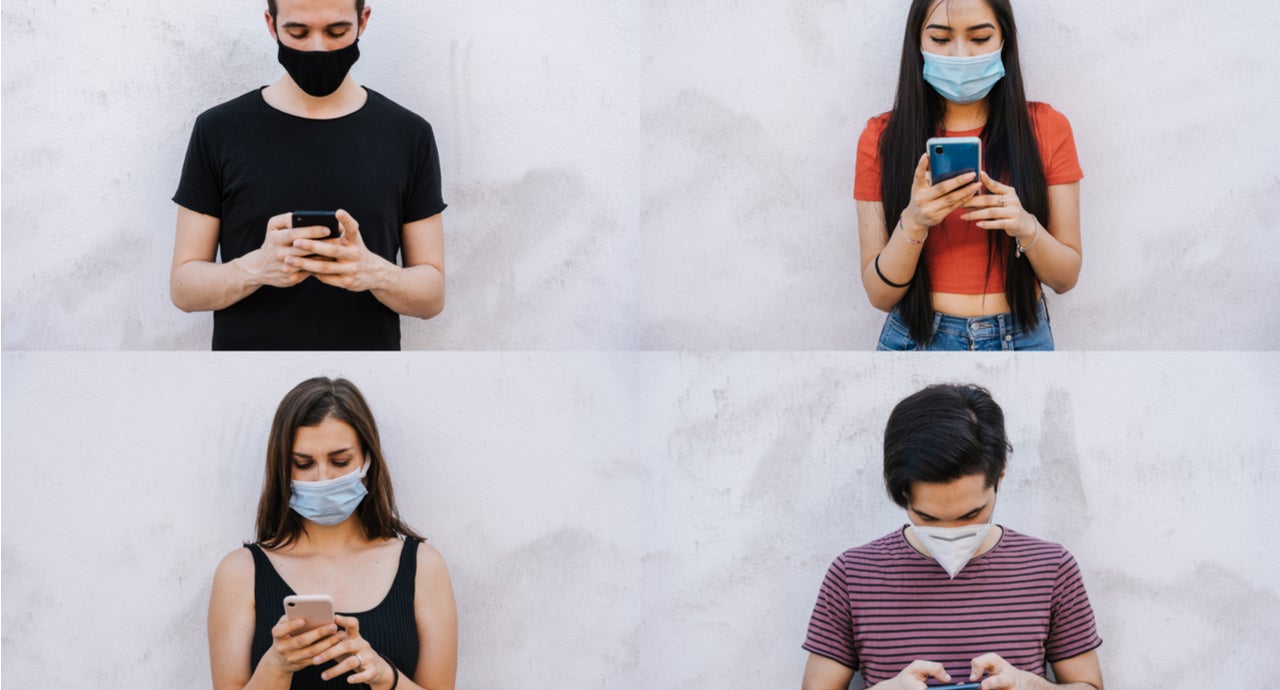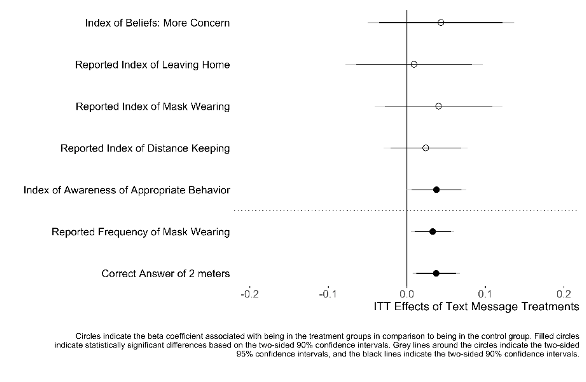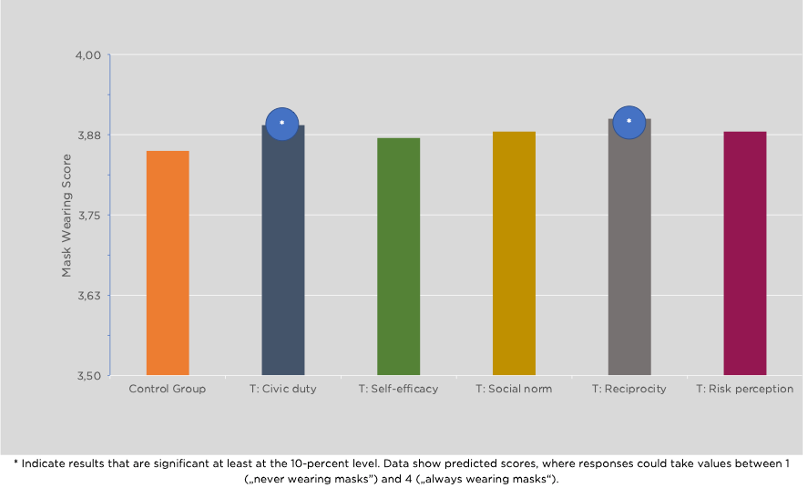Promoting compliance with COVID-19 preventive measures using behaviorally informed SMSs in Sao Paulo

Context
In the context of the COVID-19 pandemic, behavioral sciences were part of the toolkit in the quest for solutions to guide the reopening efforts, by boosting preemptive actions like keeping proper social distance, wearing masks and hand-washing. Previous work across disciplines have shown that, in the context of behavioral tools, text message reminders are particularly powerful to address limited attention, limited information-processing capabilities and present bias. Moreover, because mobile phones are relatively cheap and widely available, the use of text messages has become an efficient channel of communication with the general public. As governments around the globe were faced with the pandemic’s new and unexpected challenges, this study helped understand the extent to which a SMS campaign based on behaviorally informed messages was effective in dealing with the pandemic.
The Project
The City of São Paulo, where 96.5 percent of residents owned a cellphone in 2015, implemented a behaviorally informed text message intervention aimed at encouraging people to stay at home, wear face masks, and maintain a safe distance from others. Five different versions of a motivational messages were sent: i) reciprocity towards health workers, ii) social norms, iii) civic duty, iv) risk perception, and v) self-efficacy/ collective identity. These messages were later tested to see which were more efficient in eliciting the desired change in self-reported behavior. For that, following the delivery of the SMS, changes in self-reported behavior were recorded for 10.4 percent of the sample through a phone survey.
Behavioral Analysis
Behavioral barriers
Salience: individuals tend to direct their attention to things that are more prominent or emotionally striking and ignore those that are unremarkable, even when the objective importance of both is the same. Back then, some measures, like social distancing and handwashing, were more salient than others, like properly wearing a masks.
Overconfidence: leads us to underestimate the probability that negative events will happen to us and to overestimate the probability of positive events. Particularly in young populations, there is a tendency to believe that they will not become infected.
Cognitive overload: the cognitive load is the amount of mental effort and memory used at a given moment in time. Overload is when the volume of information provided exceeds an individual's capacity to process it. People have limited amounts of attention and memory, which means they are not able to process all the information available. In the initial months of the pandemic, the amount of new information and guidelines people had to retain was substantial.
Inertia (status quo): it is the human tendency to maintain the current state of affairs. It might be the case that people do know about the importance of wearing a facemask, for example, but have a hard time incorporating new behaviors into their daily routine.
Behavioral tools
Reminders: can take many forms, such as an email, a text message, a letter, or a personal visit reminding individual of some aspect of their decision-making. Reminders are designed to mitigate procrastination, limited attention, and cognitive overload.
Reciprocity: it is a social norm of in-kind exchange among individuals, particularly when one person's action is met with an equivalent action from another person. It is generally associated with positive reactions—for example, returning a favor with an equivalent favor.
Group identity: people have an innate need to belong to groups or sense of belonging.
Loss aversion: losses cause distress that is greater than the happiness caused by a gain of the same size, when two options that involve risk and uncertainty are relatively compared. This is why we are more willing to take risks to avoid a loss.
Intervention Design
With a sample of 75,351 citizens who had contacted the city of São Paulo’s e-government platform, the São Paulo’s innovation in government lab together with the IDB randomly assigned individuals to either receive an SMS (63,438 individuals) or to the control group in which participants did not receive a message. The treatment group was divided into five arms that received slightly different motivational messages. The content of the message varied to highlight distinct behavioral science principles:
- Reciprocity towards health workers: “healthcare professionals are risking their lives to combat the coronavirus. DO YOUR PART TO HELP THEM..
- Social norms: “the majority of people are already wearing masks. DO IT LIKE THEM.”
- Civic duty: “avoid deaths of family and friends is YOUR DUTY”.
- Risk perception: “People might be contaminated without knowing. ONE OF THEM COULD BE YOU.”
- Self-efficacy/ collective identity: “Everyone doing their part, we will defeat the coronavirus. YOUR ACTION MATTERS.”
Following the delivery of the SMS, between June 12 and July 3, 2020, all 75,351 citizens participating in the experiment were contacted by phone to answer a survey, and 7,825 (10.38 percent) responded to it, with responses rates not correlated with treatment status. The survey asked questions on beliefs about the social distancing policies, awareness of appropriate behavior, and self-reported behavior such as leaving the house, keeping distance from others and mask-wearing, as well as socio-demographic characteristics.
Challenges
- This pilot trial was limited in its capacity to have a large effect on the population. To make a real impact in the city, it was necessary to scale the intervention to larger portion of the population. Therefore, São Paulo’s innovation in government lab, partnered with the IDB and Vital Strategies to scale up the SMS intervention using a broader database of contacts.
Results
- The experiment found that text messages are an effective tool for informing the population during the pandemic. When respondents who were assigned to receive any of the SMSs are compared to those who were not, there is a statistically significant difference in knowledge on recommended behaviors (Figure 1).
- Respondents who received the “civic duty” frame, designed to prime a sense of duty to protect family and friends, were consistently better informed and more likely to always wear a mask. They were 12.75 percent more likely to choose the right answer on the distance to keep from others—i.e., an increase from 25 percent to almost 29 percent, or 3.7 percentage points. Respondents who received the “civic duty” frame were 3 percent more likely to report always wearing a mask (an increase of 2.3 percentage points) (Table 1).
- When the results are analyzed per treatment group (and compared individually to the control), three versions of the messages were significant: civic duty, self-efficacy, and the risk perception frames (Figures 2 and 3).
Figure 1. Effects of Receiving a Text Message: Overall.

Figure 2. Effects of Receiving an SMS by Treatment Arm on Social Distancing.

Figure 3. Effects of Receiving an SMS by Treatment Arm on Mask-Wearing.

Table 1. Effects of Receiving “Civic Duty” SMS Compared to Control on Social Distancing and Mask-Wearing.

Policy implications
- Understanding the potential effects of government SMSs sent to citizens has important implications in the fight against COVID and the reopening strategy of countries. The results of this project informed a scaled-up intervention where between August 10 and 14 2020, approximately 8.24 million messages were sent to more than 2.7 million citizens in the city of São Paulo, nudging them to follow the new behavioral requirements. Given that the “civic duty” message had the most consistent results in the pilot trial, it was the motivational message chosen in the scaled-up intervention.
